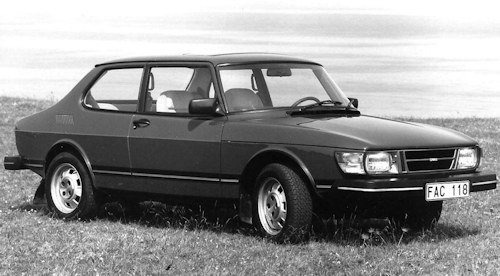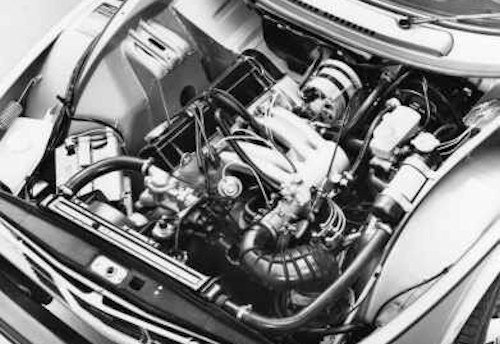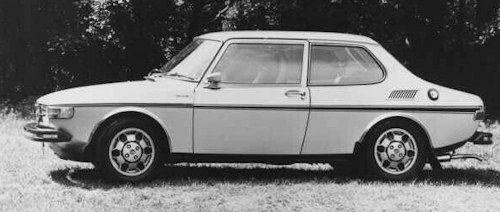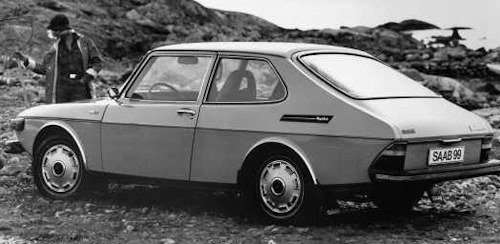Saab 99
 |
|
|
Production period: |
1968 to 1984 |
|
Class : |
motor car |
|
Body versions : |
Sedan , station wagon |
|
Engines: |
Gasoline : 1.7-2.0 liters (59-107 kW) |
|
Length: |
4350-4480 mm |
|
Width: |
1680 mm |
|
Height: |
1450 mm |
|
Wheelbase : |
2470 mm |
|
Curb weight : |
1120-1160 kg |
The Saab 99 was a car of the car manufacturer Saab , which was manufactured from early 1968 to 1984.
History
The Saab 99 was designed by Sixten Sason .Successor was introduced in the late summer of 1978 Saab 900 . As a slightly modified version of the 99 This ran from summer 1984 to mid-1987 as the Saab 90.The Saab 99 had a two or four-door self-supporting body, front-wheel drive, independent front suspension on double wishbones and rear a rigid axle , which was led by two Watt links and a Panhard transversely mounted.
From the spring of 1970, the car was also available as a four-door and was provided with a new, padded dashboard and headlight washer.The Saab 99 was elaborately made: the assembly of a vehicle took 73 hours. Modern vehicles have assembly times of less than ten hours .The body was designed so stable that the Saab 99 initially received the homologation for motor sports, without the need for separate roll bars had to be mounted .
Originally Saab had commissioned the British development company Ricardo with the construction of an engine for the 99. As the development progressed, however, it quickly became clear that designing your own engine was too expensive and too risky for such a small company as Saab.
Ricardo had best contacts to various British automakers. As a result, it was known that at the same time at the manufacturer Triumph, a team around the local designer Harry Webster developed a new four-cylinder for the Triumph automobiles. Ricardo then built a contact between Saab and Triumph. So Saab could finally take over the new Triumph engine.
Initially, this had 1.7-liter displacement, which was later increased to 1.85 liters. This could be combined with a D-Jetronic injection system. The engine was installed longitudinally over the front axle, the four-speed gearbox was under the engine. From 1970, an automatic transmission was available. Noteworthy here was the reverse mounting position of the engine with the flywheel towards the radiator and the camshaft drive in front of the bulkhead. A later two-liter version of this engine (Series H) was a pure Saab development, which in many respects (higher engine block in favor of a broader land, distributor drive directly from the camshaft) of the Triumph construction and not with that of Triumph-built two-liter variant is related.
- PERFORMANCE:1,709cc (early)
- Engine capacity: 104.28 cu in, 1,709 cu cm
- Fuel consumption: 31.4 m/imp gal, 26.1 m/US gal, 9 1 x 100 km
- Max speed: 96.3 mph, 155 km/h
- Max power (SAE): 87 hp at 5,500 rpm
- Max torque (SAE): 98 1b ft, 13.5 kg m at 3,000 rpm
- Max engine rpm: 5,700
- Specific power: 51 hp/l
- Power- weight ratio: 25.1 lb/hp, 11.4 kg/hp
- Acceleration: standing 1.4 mile 19 sec

PERFORMANCE 2.0L (1970s)
max power (DIN): 100 hp at 5,200 rpm;
max torque (DIN): 120 1b ft, 16.5 kg m at 3,500 rpm
max engine rpm: 6,000; 50.4 hp/l
max speeds: (l) 30 mph, 48 km/h; (Il) 47 mph, 76 km/h; (Ill) 70 mph, 112 km/h; (IV) 102 mph, 164 km/h
power-weight ratio: 25.6 lb/hp, 11.6 kg/hp
fuel consumption: 29.1 m/imp gal, 24.2 m/US gal, 9.7 Ix 100 km.
Together with the group partner Scania , who had gained experience with turbocharged diesel engines , they developed a modern engine with turbocharging. This worked differently than previous turbo engine concepts of competition according to the torque philosophy , characterized by a relatively small turbocharger, which was combined with a specially developed wastegate valve for boost pressure regulation. This system produced sufficient air pressure at lower engine speeds and responded faster than conventional turbochargers. The engine delivered 107 kW (145 hp) at 5,500 rpm and accelerated the vehicle from 0 to 100 km / h in 8 seconds; the top speed was just over 200 km / h. Optionally, there was the vehicle with water injection , which additionally increased the performance. However, the model was only introduced after an intensive test phase with 100 test cars, which were provided to motor journalists and test drivers for a detailed analysis.
The Saab 99 Petro was a variant of the Saab 99 presented by the company Saab in 1967. The production of the Saab 99 began at Saab-Valmet in 1969. It was the basis for Saab-Valmet brought to production Saab 99 Petro. In 1977, the first model of this kind was presented. This was produced exclusively in the Uusikaupunki(Nystad) factory. This was only available with the two-door body of the Saab 99.
As with the Horizon Petro, This had a low-compression engine. This was the two-liter turbo engine, but without turbocharger, which made only 85 hp. The top speed was 150 km / h. The tank was divided, with the larger half for the motor petroleum and 45 liters summed up. Externally, he distinguished himself next to the Petro lettering by a second filler neck, which was located to the right of the license plate.With the cessation of production of the Saab 99 also ended the production of the Petro models.
In the late summer of 1978, the Saab 900 was introduced, a slightly extended and extended model based on the Saab 99. The variety of models decreased at 99 now a bit and so the 99 Turbo was offered only in Europe for homologation purposes as a two-door model. Just like the EMS in only a small number. In the early '80s, the range of 99 models had shrunk to two- and four-door models with single carburetor 100-horsepower engine, not to compete with the model 900.From 1981, the 99 was produced only in Finland in the local factory of Saab-Valmet , but on an excellent quality level.

In 1982, the so-called H-engine, which was also used in the 900, was installed as a further development of the existing engine and a five-speed gearbox was available for selection.A gentle facelift and good equipment ensured from 1983 again increasing sales figures. Even to the last year of production in 1984, the steadily improved and now very mature car was upgraded again with contactless ignition and modified steering geometry.
Also in 1985 was not final, because the Saab 99 learned in August 1984 as the Saab 90 a sequel in an unusual style: The front end was provided with the rear of the Saab 900 Sedan and could act until August 1987 as an entry level model. Since the 900 is actually a development of the 99, the concept could exist until the end of 1993.The Saab 99 was not only manufactured at the Trollhättan (Stallbacka) plant, but also at the Uusikaupunki plant in Finland by the subsidiary company Oy Saab-Valmet . The Saab 99 was therefore also used as a police car in Finland. There were also models made in Mechelen , Belgium .
Model history
- 1970: In spring comes as an addition to the 99E with injection and automatic transmission. The performance increases from 80 to 87 hp.
- 1971: New dashboard. In addition to the engine with 1.7 l displacement comes a 1.85 l engine with carburetor or injection and without freewheel. Introduction of the headlight wiper-washer system and for the first time as standard an electric seat heating of both front seats.
- 1972: First large facelift, all models without freewheel gearbox other front suspension. Larger and differently placed combination lamps in front. Also new were powerful active bumpers at the front and rear of the car. Although these caused a slightly better accident protection, as they were up to 6 km / h deformable and self-repairing, but the car lost its graceful line and now seemed a bit clumsy.
- 1973: Side impact protection in the doors, shock-absorbing inner sky. There was also a 1.971 liter engine. The new engine was introduced with the start of production of the Saab 99 EMS with Bosch D-Jetronic, later also on the carburettor versions. Black grille with polished aluminum trim.
- 1974: In addition to the two- and four-door models came on a variant with hatchback and large tailgate with low sill on the market, the Combi-Coupé (short: CC) was called. This had a folded rear seat a cargo volume of 1,600 liters. New seats with integrated head restraints in the front and in the saloon rear neck impact protection with rear window defroster nozzles for rear window heating and improved bumpers on the outside, which are now self-repairing up to 8 km / h.
- 1975: Second extensive facelift, completely revised technology on suspension and drive, the engine power increases from 95 hp to 100 hp and from 110 hp to 118 hp. The grille is now made of plastic. The Triumph engine is eliminated. As an additional model, a two-seat van comes into the offer. In the model EMS, the sports variant, the K-Jetronic is equipped and the car went from now next to the Saab 96 in rallying to the start - driven by Stig Blomqvist and Per Eklund. The rally version received 1976 cylinder heads with 16 valves and two camshafts. This rally-proven variant was also the basis for the turbo engine from Saab.
- 1976: Expansion of the engine range by a dual-engined engine with 108 hp. Electric rear window heating also for two- and four-door. As an additional body variant, the five-door Combi coupe is introduced and a luxury version with 118 hp engine equal to the EMS but only 4-door and with power steering namely GLE.
- 1977: Small model care externally by larger rear lights in the sedan and enlarged combination lights in all variants front. The combination lights contained a cornering light and side reversing lights (not approved in Germany). In the fall, the model Turbo was a three-door Combi Coupé in pearly white on the 47th IAA in Frankfurt and was delivered from the fall of the year to customers, primarily in the US. Pre-production of 100 vehicles for test purposes already in advance as 'EMS-Turbo' launched to motor journalists and car testers in the spring.
- 1978: Series production of the Saab 99 Turbo begins with the model year. He is equipped with a 2.0-liter engine, the charged 145 hp and 235 Nm torque possesses. Only available as 3-door CombiCoupe in black and carinal red, with sunroof as standard. GLE model now only 5-door.
- 1979: Technical adaptation to the Saab 900, simplification of the equipment, including omission of the neck protection of the rear passengers. Fewer model variants. Turbo no longer available in 3 doors. But now as a 2-door sedan only for Europe in marble and acacia green in small numbers as well as EMS.
- 1980: Longer bumpers and further technical adaptation to the Saab 900. Only available as a sedan. Two-door turbo in fixed small numbers but also available with five-speed gearbox.
- 1981: engines with 100 hp carburetor or 118 hp injection. Four or five gears, no automatic transmission available. Production only in Uusikaupunki / Finland at SAAB-Valmet.
- 1982: Due to changes in the front area, the 99 can now be equipped with the H engine from the 900. Exterior new side trim and grille from the 99 EMS.
- 1983: Grille is adapted in design to the Saab 900.
- 1984: Contactless electronic ignition. Production will be discontinued in April.

Technical
-
Saab 99 Technical details and specifications (1968-1984)
ENGINE: 1,709cc (early)
front, 4 stroke
cylinders: 4, in line
bore and stroke: 3.29 x 3.07 in, 83.5 x 78 mm
engine capacity: 104.28 cu in, 1,709 cu cm
compression ratio: 9
cylinder block: cast iron
cylinder head: light alloy
crankshaft bearings: 5
valves: 2 per cylinder, overhead, thimble tappets
camshafts: 1, overhead
lubrication: gear pump, full flow filter
lubricating system capacity: 6.16 imp pt, 7.40 US pt
carburation: 1 Zenith- Stromberg 175 CD horizontal carburettor
fuel feed: mechanical pump
cooling system: waterENGINE: 1,854 cc
4 stroke; 4 cylinders
slanted at 45°, in line;
Engine capacity: 113.1 cu in, 1,854 cc
bore and stroke: 3.43 x 3.07 in, 87 x 78 mm
compression ratio: 9: 1
max power (SAE): 95 hp at 5,500 rpm
max torque (DIN): 109 1b ft, 15 kg m at 3,000 rpm
max engine rpm: 5,700 51.2 hp/l
cast iron cylinder block, light alloy head
5 crankshaft bearings
valves: overhead, thimble tappets
camshafts: 1, overhead
lubrication: gear pump, full flow filter
6.2 imp pt, 7.4 US pt, 3.5 1:
1 Zenith-Stromberg 175 CD horizontal carburettor
fuel feed: mechanical pump; liquid-cooled, expansion tank
coolant capacity: 15 imp pt, 18 US pt, 8.5 1,
thermostatically controlled fan.ENGINE 2.0L (1970s)
front, 4 stroke
4 cylinders, slanted at 450, in line
121.1 cu in 1,985 cc (3.54 x 3.07 in, 90 x 78 mm)
compression ratio: 9.2:1
cast iron cylinder block, light alloy head
5 crankshaft bearings
valves: overhead, thimble tappets
camshafts: 1, overhead, driven by double chain
lubrication: rotary pump, full flow filter
carburettor; Zenith-Stromberg 175 CD-2S horizontal
fuel feed: mechanical pump; liquid-cooled,
expansion tank, 14.1 imp pt, 16.9 US pt. 8 1
thermostatically-controlled fan.Saab B engine Technical details and specifications (1976-1993)
No. of cylinders 4/OHC
Capacity 1985cc (1971)
Compression ratio 9.2:1
Firing order 1-3-4-2
Suitable for unleaded petrol No
Minimum octane rating 98RON
Fuel system Make Bosch Type K-Jetronic
Ignition coil Make Bosch Type 0 221 119 027
Ballast resistance 0.4-1.4Ohm
Distibutor Make Bosch No. 0 231 170 197
Contact breaker gap 0.4mm
Fuel pump pressure 4.5-5.2 bar
Oil pressure 3.8-4.2 bar
Radiator cap 0.55-0.6 bar
Thermostat opens 85°C
Starter motor Make Bosch Type 0 001 311 108
Maximum cranking amps 162-198A
Alternator/Regulator Make Bosch Type 0 120 489 997
Voltage regulator Type 0 190 601 006
Regulated voltage 13.9-14.8V© Motor car History
TRANSMISSION
driving wheels: front
clutch: single dry plate, hydraulically controlled
gearbox: mechanical, in unit with differential and engine, transfer reduction train beneath engine
ratio 0.95; gears: 4, fully synchronized
ratios: I 3.440, II 2.080, III 1.380. IV 1, rev 3.070
final drive: spiral bevel; axle ratio: 3.890CHASSIS
integral front suspension: independent, wishbones, coil springs, telescopic dampers
rear: rigid axle, twin longitudinal leading arms, twin swinging trailing radius arms, transverse linkage bar, coil springs, telescopic dampers.STEERING
rack-and-pinion
turns lock to lock: 4.10.BRAKES
disc (diameter 11.02 in, 28 cm), 2 separate X hydraulic circuits, servoELECTRICAL EQUIPMENT
12 V
60 Ah battery
55 A alternator
Bosch distributor
2 halogen headlamps with wipers and washers.DIMENSIONS AND WEIGHT saloon/sedan;2 doors
wheel base: 97.36 in, 247 cm;
tracks: 54.72 in, 139 cm front, 55.51 in, 141 cm rear: length: 174.02 in, 442 cm; width: 66.54 in, 169 cm
height: 56.69 in, 144 cm
ground clearance: 6.89 in, 17.5 cm;
dry weight: 2,558 1b, 1,160 kg
distribution of weight: 62% front, 38% rear
turning circle (between walls): 34.8 ft, 10.6 m© Motor car History
Saab 99 (1980s)
Saab
99 GL
Engine:
4-cylinder in-line engine (four-stroke)
displacement:
1985 cm³
Bore × stroke:
90 × 78 mm
Power at 1 / min:
74 kW
(100 hp)
at 5200Max. Torque at 1 / min:
162 Nm at 3500
Compression:
9.5: 1
Fuel supply:
1 × Zenith Stromberg 175
Valve control:
Overhead camshaft, drive via chain
Cooling:
water cooling
Transmission:
4-speed gearbox
front-wheel driveFront suspension:
Wishbones top and bottom, coil springs (struts)
Rear suspension:
Rigid axle, two Watt linkage along, panhard rod, coil springs
brakes:
Disc brakes all around, servo
Steering:
Rack and pinion steering
Body:
Sheet steel, self-supporting
Track front / rear:
1400/1430 mm
Wheelbase:
2475 mm
Dimensions:
4480 × 1690 × 1440 mm
Empty weight:
1120-1160 kg
Maximum speed (factory):
160 km / h
0-100 km / h (factory):
14.5 s
Consumption
(liters / 100 kilometers, plant):11.6 p
Service
-
Saab 99 Service Guide (1968-1984)
1,709cc (early)
Fuel: 96 oct petrol
Engine oil change: 6.16 imp pt, 7.39 US pt. 3.5 1, SAE 10W-40, change every 6,200 miles, 10,000 km
Gearbox and final drive oil: 5.28 imp pt, 6.34 US pt, 3 1, SAE 80, change every 6,200 miles, 10,000 km
Cooling system capacity: 15.14 imp pt, 18.18 US pt
Greasing: every 6,200 miles, 10,000 km
Normal tyre pressure: front 24 psi, 1.7 atm, rear 24 psi, 1.7 atm.2.0L(1970s)
- fuel: 97 oct petrol
- oil: engine 6.2 imp pt. 7.4 US pt, 3.5 1, SAE 1OW-40, change every 6,200 miles, 10,000 km
- gearbox 5.3 imp pt, 6.3 US pt, 3 1, SAE 75-80, change every 12,400 miles, 20,000 km
- final drive 2.1 imp pt. 2.5 US pt. 1.2 1, SAE 75 or 80 EP, change every 12,400 miles, 20,000 km
- greasing: every 6,200 miles, 10,000 km
- tappet clearances: inlet 0.00.6-0.012 in, 0.15-0.30 mm, exhaust 0.014-0.020 in, 0.35-0.50 mm;
- valve timing: 12° 56° 56v 12°
- width of rims: tyres: 165 SR x 15. 4.5"
- tyre pressure: front 28 psi, 1.9 atm, rear 28 psi, 1.9 atm.
- fuel tank: 12.1 imp gal, 14.5 US gal, 55 1.
- carrying capacity: 926 1b, 420 kg
Saab B engine Technical details and specifications (1976-1993)
Spark plugs Electrode gap 0.7-0.8mm
Spark plugs Tighten 28 Nm
Spark plugs Original equipment NGK Type BP6ES
Spark plugs Make Bosch Type W7DC
Spark plugs Make Champion Type N9YCC
Spark plugs Make NGK Type BP6ES
Valve clearance -INLET 0.15-0.30 mm check cold
Valve clearance -EXHAUST 0.35-0.50 mm check cold
Drive belt size - alternator 9,5x975mm
Drive belt tension - alternator/PAS/AC 12mm
Engine oil grade - normal/moderate climate 10W/40 SAE
Engine oil change with filter 3.8 litres
Cooling system 9.5 litresCylinder head Tightening torques instructions
Stage 1 Tighten 60 Nm
Stage 2 Tighten 80 Nm
Stage 3 Tighten
Run engine 15 minutes
Stage 4 Tighten
Wait30 minutes
Stage 5 Tighten
Loosen+80 Nm
Stage 6 Tighten 90°© Motor car History
